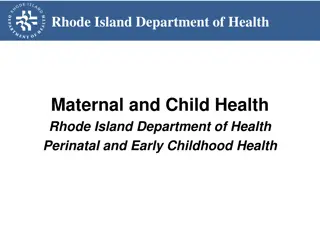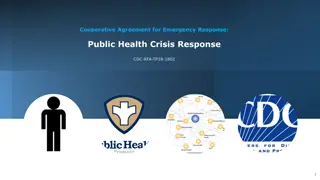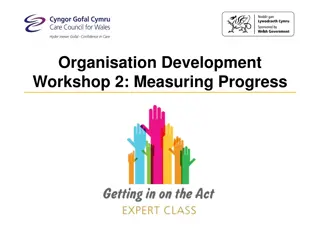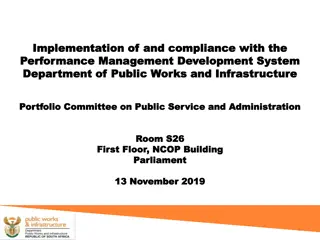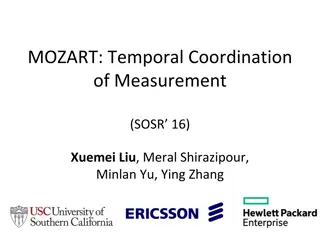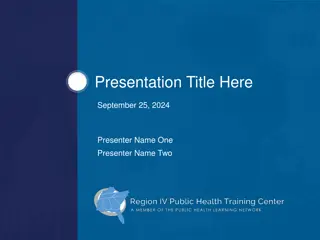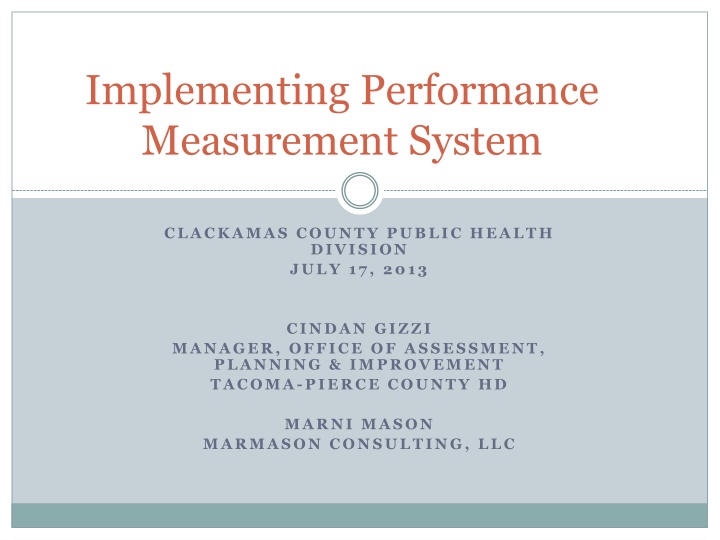
Implementing Performance Measurement System in Public Health Division
This content discusses the implementation of a performance measurement system at Clackamas County Public Health Division in July 2013. It introduces Cindan Gizzi, the manager of the Office of Assessment, Planning & Improvement, and provides insights into using performance measures, identifying key performance questions, and lessons learned in performance measurement. The content also highlights Tacoma-Pierce County Health Department's performance measures and a detailed performance measure description form for Chlamydia positivity rate.
Download Presentation

Please find below an Image/Link to download the presentation.
The content on the website is provided AS IS for your information and personal use only. It may not be sold, licensed, or shared on other websites without obtaining consent from the author. If you encounter any issues during the download, it is possible that the publisher has removed the file from their server.
You are allowed to download the files provided on this website for personal or commercial use, subject to the condition that they are used lawfully. All files are the property of their respective owners.
The content on the website is provided AS IS for your information and personal use only. It may not be sold, licensed, or shared on other websites without obtaining consent from the author.
E N D
Presentation Transcript
Implementing Performance Measurement System CLACKAMAS COUNTY PUBLIC HEALTH DIVISION JULY 17, 2013 CINDAN GIZZI MANAGER, OFFICE OF ASSESSMENT, PLANNING & IMPROVEMENT TACOMA-PIERCE COUNTY HD MARNI MASON MARMASON CONSULTING, LLC
Introducing Cindan Gizzi Cindan Gizzi, MPH, manages the assessment, planning and improvement programs and serves as deputy director pro tem at the Tacoma-Pierce County Health Department in Washington State. She is a member of NACCHO s Quality Improvement Leaders; serves on Robert Wood Johnson Foundation s PHQIX Expert Panel; is part of NACCHO s Accreditation Speakers Bureau of Champions; and leads the Public Health Performance Management Center for Excellence at Tacoma-Pierce.
Using Performance Measures Identify and agree what matters Collect the right information Learn and improve performance Key performance questions Outcome, output, and performance measure definitions Internal and external stakeholder assessment Performance measure design template Performance management spreadsheet or database Building blocks of performance/quality/ learning culture Performance improvement meetings
Lesson Learned Reward improvement and learning Performance measurement is not punishment!
Performance Measure Description Form Performance measure: The rate of Chlamydia (CT) positivity at Infertility Prevention Project (IPP) sites. Target population: People being tested for Chlamydia Numerator: Positive CT tests at IPP sites Denominator: All CT tests at IPP sites Which are you using a target or benchmark? What is the target/benchmark? 8.0% SMART objective: Decrease the rate of CT positivity at IPP sites from 8.1% to 8.0% by the end of 2011. Source of data: DOH records Who will collect the information? How often will the data be analyzed and reported? Baseline measurement data and date(s): 2006: 9.3% 2007: 10.5% Definitions and other comments: Hall. Target Jim Marshal quarterly 2005: 10.1% 2008: 8.6% 2009: 8.2% 2010: 8.1% IPP sites include TPCHD, Planned Parenthood, Remann
Tacoma-Pierces Reporting Schedule Performance Measure Level Department QIC Review What Annually Feb Report all measures Division Semi-annually Feb/Aug Report % of PMs meeting target Highlight 1 success Highlight 1 falling short of target - Key insights -Actions Report % of PMs meeting target (Discussion of PMs should happen within program) Program Quarterly Feb/May/Aug/Nov
Who Do We Report Measures to? QI Council (quarterly) Board of Health (annually) Staff (semi-annually)
Performance Measure Title Key Insights Why are we getting the results we are getting? Are we progressing toward our target? Have we achieved our target? Measure Description: Target: Are there any unintended consequences of our actions? Actual: Status: Next Actions What is likely to happen in the future? What are possible areas for improvement? Outcome Owner: Data Source: Link to Strategic Plan:
Small Drinking Water Systems Percent of population served by smaller water systems that do not meet drinking water standards Key Insights Small water system managers face numerous challenges due to lack of water system management experience Through education and technical assistance water systems are better able to meet system standards Measure Description: Target:20% Actual: 22% (12,179/55,034) Line of Sight: division level PM not met, program level PM met Status : Outcome Owner: Brad Harp Next Actions Ongoing education and technical assistance is critical due to the high level of turnover in small water system managers and operators QI needed to evaluate effectiveness of current assistance strategies. Wash. St. Dept. of Health and Envision Database Data Source: SD 1, 3 and 4: Pierce County has access to safe & reliable water resources Link to Strategic Plan:
Performance Management Conversations Four questions that drive performance management conversations at Sedgwick County Health Department: 1. What was a key opportunity that you pursued? 2. Which roadblocks/hurdles did you experience? What potential QI project(s) might help with overcoming the barrier(s)? 3. State one way that you believe you improved the community s health status. 4. What is ONE research study (or program evaluation study) that you would find useful in the planning/implementation of your program?
QI Opportunity: Grants Billing Customer Satisfaction Scores Performance Measure: Percent of Department staff who are satisfied with the grants billing process. April 2011 October 2011 April 2012 December 2012 66% 74% 54% 60%
WHAT QUESTIONS DO YOU HAVE?
Establish an Agency Measurement System The most important monitoring action you can take is the development of program-level reports that are made available to every staff person in the organization on a regular basis Supervisor and program manager reports that work with the same data elements These reports should be used on a regular basis to understand whether the program activities are performing as expected (cost, utilization, outcomes, etc.) 18 MarMason Consulting
Performance Measures Agency level measures (between 12- 18) Modeled after Healthy People 2020 Leading Health Indicators or County Health Rankings. . . plus any key additional Approx. 10-20 performance measures per division and/or program Percent of solid waste complaints responded to within 20 days Reduce the rate of positivity at Infertility Prevention Project (IPP) sites Percentage of Positive Steps clients who engage in services for 30. days or more who have a 10% reduction on three youth violence risk factors 19 MarMason Consulting
Agency Level Performance Measures Measure Indicator Responsibility Increase the percentage of kindergarten enrollees that are up to date on their immunizations upon school entry from 86% to 92% by 2014. Decrease the percentage of adult smokers to 16% by 2014. Reduce the rate of increase for adult obesity to 0% by 2014. Increase the percent of youth who are physically active for at least 60 minutes per day from 16.8% to 18.5% by 2014. Increase the number of adults receiving opiate treatment service by 23% by 2014, to 800 patients. Increase the percentage of sexual partners treated for sexually transmitted diseases by 10% by 2014. Improve immunization rates Reduce tobacco use Reduce overweight & obese populations Increase healthy physical activity Reduce substance abuse Increase responsible sexual behavior MarMason Consulting 20
Success can be Measured in Stages Health Issue/ Goal Process Outcome 1. Short term 2. Mid-range Results Outcome 3. Long term Health Status or Risk Indicator 21 Improve Childhood immunization rates of 2 year olds Percent of planned materials distributed to increase provider awareness (Goal 100%) Percent of children with records kept in Child Profile (Goal to increase from year to year) Percent of children 0 to 24 mo. completing the recommended series on time (Goal -increase ) Disease rates related to the series are very low or approaching none (such as Pertussis, measles) MarMason Consulting
Line of Sight Concept MarMason Consulting 22
Reporting & Monitoring Reporting structure Quarterly (Division/Program) and annually (Agency) to QI Council Dashboard annually to Board of Health Performance measurement roles/responsibility matrix Measures linked to financial dashboards Performance management policy MarMason Consulting 23
Program Reporting Example STD Program Performance Measure: Increase percentage of contacts of STD exposures where treatment was obtained 2009 Baseline Current Status Target Varianc e 70% 72% 80% -8% Quality Improvement Project Performance Measures: 1. Decrease average # days to report STD cases to PH 2. Increase % clinics reporting STDs within county average 24 MarMason Consulting
Lets Discuss What specific measures of performance are you monitoring and reporting for your program area? How do you currently use your results to identify opportunities for improvement? MarMasonConsulting
WHAT QUESTIONS DO YOU HAVE?



